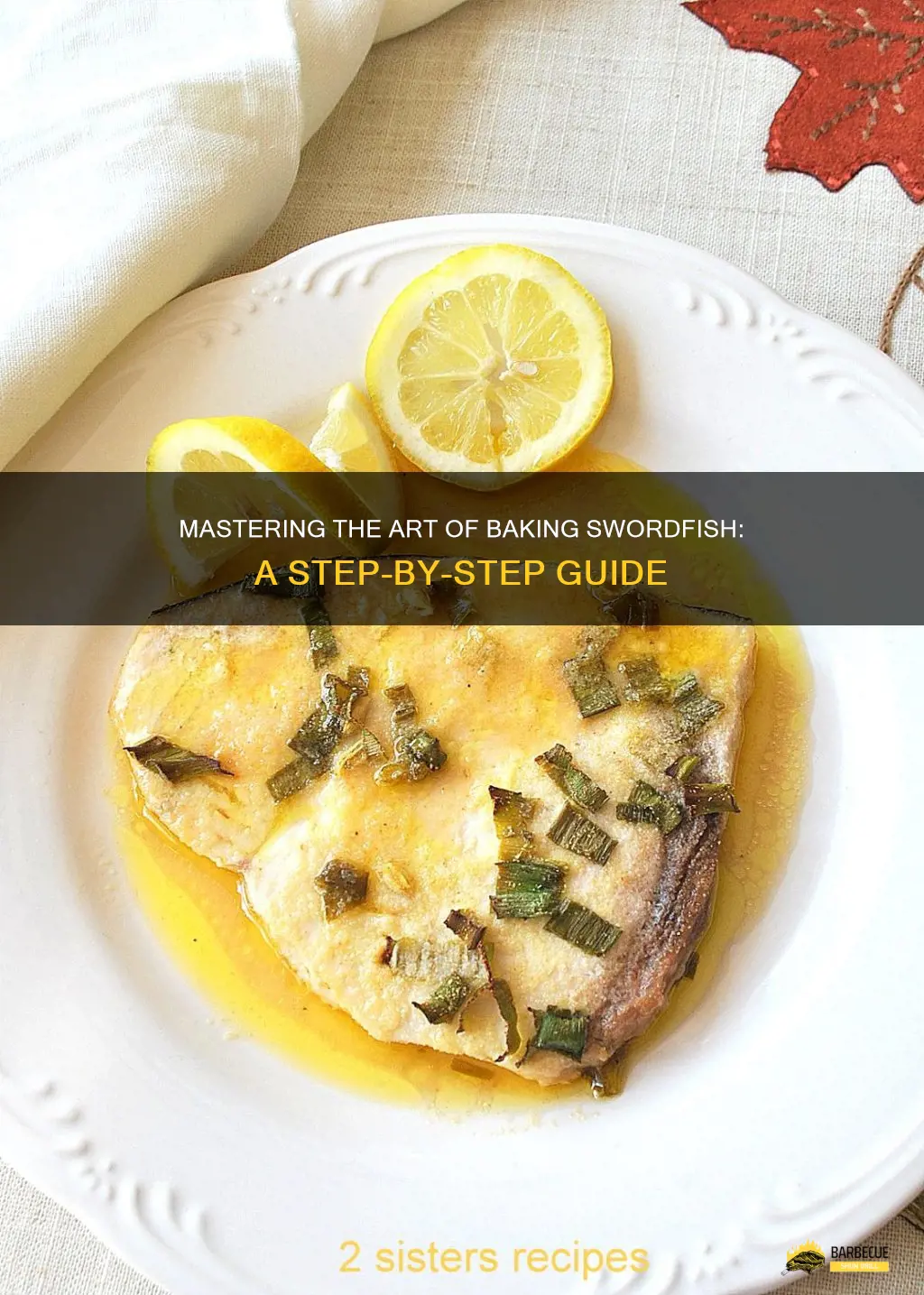
Swordfish is a delicious, meaty fish that is perfect for baking. Whether you're a seasoned chef or a beginner in the kitchen, baking swordfish is a simple and impressive way to cook this flavorful fish. With its firm texture and mild flavor, swordfish is versatile and can be paired with a variety of seasonings and accompaniments to create a delicious meal. So, grab your apron and get ready to learn how to bake swordfish to perfection!
| Characteristics | Values |
|---|---|
| Cooking Method | Grilling, baking, broiling |
| Temperature | 400-450°F |
| Cooking Time | 10-12 minutes per inch of thickness |
| Internal Temperature | 145°F |
| Seasoning | Salt, pepper, garlic, lemon juice |
| Marinade | Olive oil, lemon juice, herbs |
| Toppings | Fresh herbs, diced tomatoes, capers, olives |
| Serving Suggestions | Rice, roasted vegetables, salad |
| Health Benefits | High in protein, omega-3 fatty acids |
| Flavor Profile | Mild, slightly sweet |
| Texture | Firm and meaty |
| Preferred Cooking Degree | Medium to medium-well |
| Side Dishes | Grilled asparagus, mashed potatoes, quinoa |
| Pairings | Chardonnay, Sauvignon Blanc, Pinot Noir |
What You'll Learn

Choosing and preparing the swordfish fillets
When it comes to cooking swordfish, choosing and preparing the fillets is a crucial step in ensuring a delicious and flavorful outcome. Here's a guide to help you select the best swordfish fillets and prepare them for baking:
Choosing Swordfish Fillets:
- Start by looking for swordfish fillets that are firm and have a fresh, ocean-like smell. Avoid fillets that have a strong fishy odor, as this may indicate they are not fresh.
- Look for fillets that have a pinkish-white color with a shiny, moist appearance. Avoid fillets that look dull or dry, as these may not be as fresh.
- For the best quality, opt for swordfish fillets that are at least 1 inch thick. Thinner fillets are more prone to drying out during the cooking process.
Preparing Swordfish Fillets:
- Before cooking, rinse the swordfish fillets under cold water and pat them dry with paper towels. This helps remove any impurities and excess moisture from the surface.
- Remove the skin from the fillets, if it is still attached. Use a sharp knife to gently separate the skin from the flesh, starting at one end and sliding the blade along the skin, keeping it as close to the skin as possible.
- Check the fillets for any remaining bones and use tweezers or fish bone pliers to remove them. Run your fingers along the fillet to feel for any small bones and carefully pull them out.
- Once the fillets are bone-free, season them generously with salt and pepper. You can also add other herbs and spices according to your preference, such as garlic powder, paprika, or dried herbs like thyme or rosemary.
- For added flavor, you can marinate the swordfish fillets for 30 minutes to 1 hour in a mixture of lemon juice, olive oil, minced garlic, and your choice of herbs. This step is optional but can enhance the taste of the fish.
By selecting high-quality swordfish fillets and properly preparing them, you are setting the stage for a tasty and satisfying meal. With your fillets ready to go, you can now proceed to bake the swordfish according to your chosen recipe.
The Best Cooking Method for Baking Fish in Foil
You may want to see also

Seasoning and marinating the swordfish for optimal flavor
When it comes to cooking swordfish, seasoning and marinating play a crucial role in enhancing its natural flavors. Whether you decide to grill, bake, or pan-sear your swordfish, a well-seasoned and marinated fish is always a delight to the taste buds. So, if you want to elevate your swordfish dish to the next level, here's a guide on how to season and marinate the fish for optimal flavor.
- Selecting the right swordfish: Before seasoning and marinating, it's essential to choose a fresh and high-quality swordfish steak. Look for a steak that has a firm texture, shiny appearance, and smells fresh like the ocean. Avoid fish with an ammonia-like smell, as it indicates it's not fresh.
- Preparing the Marinade: To add depth and flavor to your swordfish, prepare a marinade with a combination of acidic, sweet, and savory ingredients. One popular marinade recipe is a combination of lemon juice, olive oil, minced garlic, chopped fresh herbs like parsley or dill, salt, and pepper. You can also experiment with different flavors by adding ingredients like soy sauce, balsamic vinegar, honey, or ginger.
- Marinating the Swordfish: Place the swordfish steak in a shallow dish or a resealable plastic bag. Pour the marinade over the fish, ensuring that it is evenly coated. If you are using a dish, cover it with plastic wrap, or if you opt for a bag, squeeze out the excess air before sealing it. Marinate the swordfish in the refrigerator for at least 30 minutes, but ideally, let it sit for 1 to 2 hours to allow the flavors to penetrate the fish.
- Avoid Over-marinating: While marinating enhances the flavor of swordfish, be cautious not to over-marinate the fish as the acid in the marinade can break down the texture and make it mushy. The optimum marinating time for swordfish is between 30 minutes to 2 hours. If you marinate it for longer, the texture may become compromised.
- Seasoning the Swordfish: After marinating, remove the swordfish from the marinade and pat it dry with a paper towel. This step is crucial to ensure the fish browns properly during cooking. Season your swordfish liberally with salt and pepper on both sides to enhance the flavor.
- Letting it Rest: Before baking, allow the seasoned swordfish to rest at room temperature for about 10-15 minutes. This will ensure even cooking and help the fish retain its moisture.
- Preheating the Oven: Preheat your oven to 400°F (200°C) to ensure it's adequately heated when cooking the swordfish.
- Baking the Swordfish: Place the swordfish on a baking sheet or in a baking dish. Drizzle a bit of olive oil or butter over the top of the fish to keep it moist while baking. Bake the swordfish for approximately 10-15 minutes, depending on the thickness of the steak. The fish is done when it flakes easily with a fork and reaches an internal temperature of 145°F (63°C).
- Serving Suggestions: Once baked, you can serve the swordfish as is or pair it with your favorite side dishes. Some popular options include grilled vegetables, roasted potatoes, or a fresh salad. The choice is yours!
By following these steps and paying attention to the seasoning and marinating process, you'll create a mouthwatering and flavorful swordfish dish that will impress your family and guests. So, go ahead, try out different marinades and seasonings, and elevate your swordfish cooking game!
Counting the Calories: How Many Calories Are in Baked Pacific Cod Fish?
You may want to see also

Grilling or broiling the swordfish to perfection
When it comes to cooking swordfish, grilling or broiling are two popular methods that can result in a deliciously flavorful and moist dish. Whether you are a seasoned chef or a beginner in the kitchen, mastering the art of grilling or broiling swordfish is within your reach. In this blog post, we will walk you through the steps to grill or broil swordfish to perfection.
Ingredients:
- Swordfish steaks
- Olive oil
- Lemon juice
- Salt
- Pepper
- Additional seasonings or herbs of your choice (optional)
Equipment:
- Grill or broiler
- Tongs or spatula
- Basting brush
- Aluminum foil (if using a grill)
Step 1: Prepare the Swordfish
Start by patting the swordfish steaks dry with a paper towel to remove any excess moisture. This will help the seasonings adhere to the fish better. If needed, trim any dark or discolored parts of the fish. Allow the swordfish to come to room temperature for about 20 minutes before cooking.
Step 2: Preheat the Grill or Broiler
If you are using a gas or charcoal grill, preheat it to medium-high heat. If you are using a broiler, set the oven rack about 5-6 inches below the heat source and preheat the broiler on high.
Step 3: Season the Swordfish
Drizzle olive oil over the swordfish steaks to coat them lightly. Sprinkle both sides with salt, pepper, and any additional seasonings or herbs of your choice. Rub the seasonings into the fish gently to ensure they are evenly distributed.
Step 4: Grill or Broil the Swordfish
Grilling:
If you are grilling swordfish, lightly oil the grill grates or use aluminum foil to prevent the fish from sticking. Place the swordfish directly on the grill grates or on the aluminum foil if using. Close the lid and cook for about 4-5 minutes per side, or until the fish becomes opaque and flakes easily with a fork. Avoid overcooking the swordfish as it can result in dryness.
Broiling:
If you are broiling swordfish, line a baking pan with aluminum foil for easier cleanup. Place the swordfish on the prepared pan and place it under the preheated broiler. Cook for about 4-5 minutes per side, or until the fish becomes opaque and flakes easily with a fork.
Step 5: Baste the Swordfish
For added flavor and moisture, baste the swordfish with a mixture of olive oil and lemon juice using a basting brush. This step is optional but can enhance the taste of the fish.
Step 6: Serve and Enjoy
Once the swordfish is cooked to your desired doneness, remove it from the grill or broiler and let it rest for a few minutes before serving. This allows the juices to redistribute and ensures a juicy and flavorful result. Serve the grilled or broiled swordfish with your favorite side dishes, such as roasted vegetables, rice, or a fresh salad.
Grilling or broiling swordfish is a fantastic way to enjoy this firm and meaty fish. By following these simple steps, you can achieve a perfectly cooked swordfish with a flavorful crust and moist interior. So fire up your grill or preheat your broiler, and get ready to savor this delicious seafood delight!
The Ultimate Guide to Baking a Delicious Mullet Fish
You may want to see also







